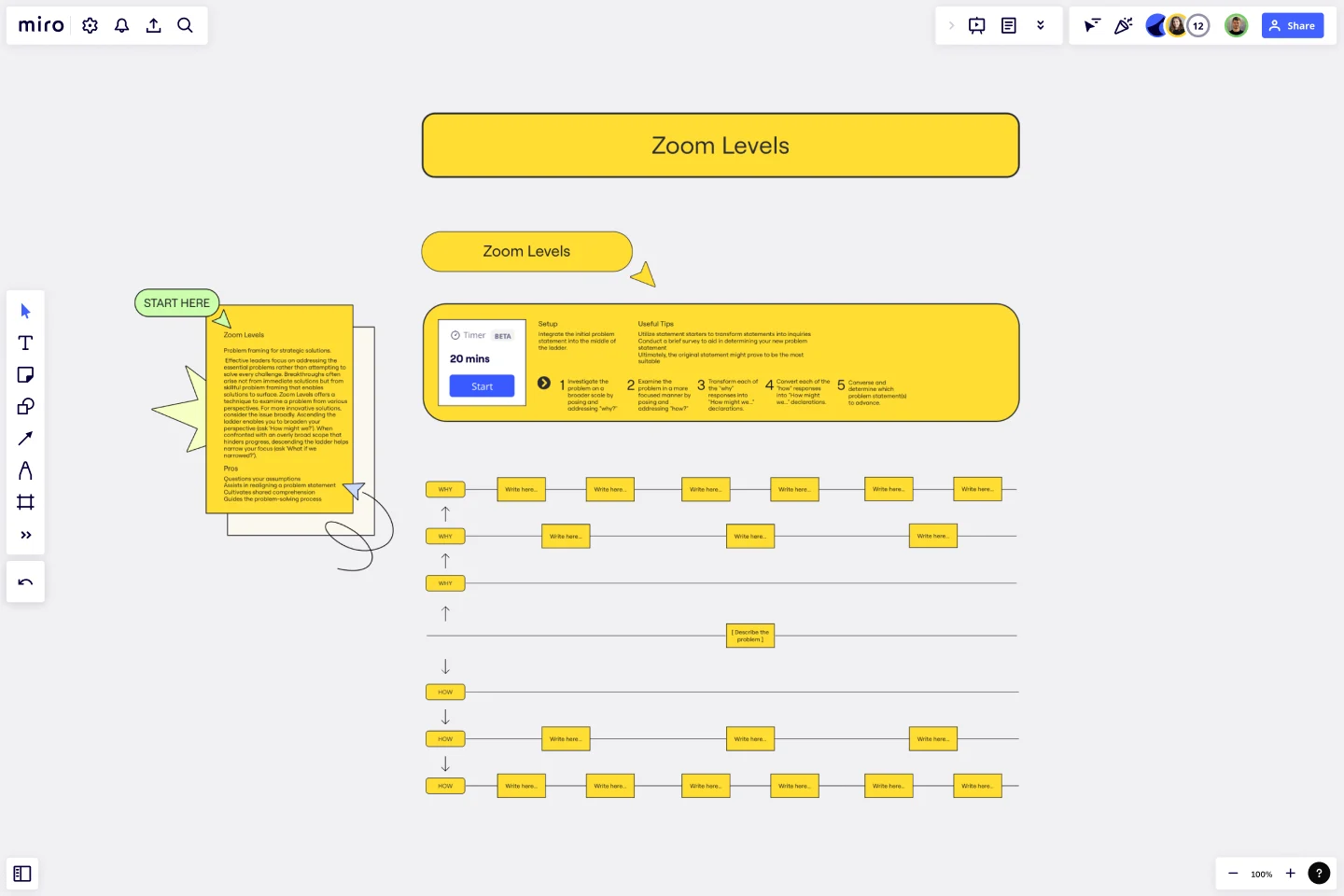Zoom Levels Template
Frame problems from a different perspective with the Zoom Levels Template.
About the Zoom Levels Template
Effective leaders understand that it is not always possible to solve every challenge. Instead, they focus on addressing the essential problems that are most critical to the success of their organization. They recognize that breakthroughs often arise not from immediate solutions but from skillful problem framing that enables solutions to surface.
One tool that can be used to examine a problem from various perspectives is the Zoom Levels Template. This technique involves considering the issue broadly to develop more innovative solutions. Ascending the ladder enables you to broaden your perspective by asking, "How might we?" This approach encourages you to think creatively and consider all possible solutions to the problem.
However, it is important to narrow your focus when confronted with an overly broad scope that hinders progress. This is where descending the ladder comes in. By asking, "What if we narrowed?" you can identify the most critical aspects of the problem and focus your efforts on finding a solution that addresses those specific issues.
Benefits of using the template
Question your assumptions.
Assist in realigning a problem statement.
Cultivate shared comprehension.
Guide the problem-solving process.
How to use the template in Miro
Investigate the problem on a broader scale by posing and addressing "why?”.
Examine the problem in a more focused manner by posing and addressing "how?”.
Transform each of the "why" responses into "How might we..." declarations.
Convert each of the "how" responses into "How might we..." declarations.
Converse and determine which problem statement(s) to advance.
Setup
Integrate the initial problem statement into the middle of the ladder.
Useful tips
Utilize statement starters to transform statements into inquiries.
Conduct a brief survey to aid in determining your new problem statement.
Ultimately, the original statement might prove to be the most suitable.
Get started with this template right now.
BPM
Works best for:
Diagramming
The BPM (Business Process Management) template is a visual tool for modeling, analyzing, and optimizing business processes. It provides a structured framework for documenting process flows, identifying bottlenecks, and improving efficiency. This template enables organizations to streamline operations, enhance productivity, and drive business performance. By promoting process transparency and agility, the BPM template empowers teams to achieve operational excellence and deliver value to stakeholders.
Empathy Map by Pino de Francesco
Works best for:
Research & Design, Market Research
The Empathy Map template helps you understand your users' needs, behaviors, and experiences. By visualizing what users think, feel, see, hear, and do, you can gain deep insights into their motivations and pain points. This template is essential for creating user-centered designs and improving customer experiences.
Storyboarding Toolkit
Works best for:
Storyboard, Design, Planning
Streamline your storytelling process with the Storyboarding Toolkit. This comprehensive template provides all the tools you need to create detailed storyboards, including scene planning, character development, and timeline management. It's perfect for filmmakers, designers, and marketing teams looking to create cohesive and engaging narratives. Use this toolkit to organize your ideas, ensure consistency, and bring your stories to life with clarity and precision.
Proto Persona Template
Works best for:
UX, UX Research, Product Design
The Proto Persona Template is tailored to capture the essence of hypothetical user segments. It encapsulates key attributes such as user needs, behaviors, and potential pain points. One of its standout benefits is its ability to foster empathy. By visualizing and understanding these preliminary user profiles, design and strategy teams can tap into a deeper connection with their target audience, ensuring that solutions resonate authentically and address genuine needs.
Service Blueprint to the Metaverse
Works best for:
Research & Design
Explore the future of service design with the Service Blueprint to the Metaverse. This template helps you map out service experiences within virtual environments. Use it to visualize interactions, identify opportunities, and plan seamless service delivery in the metaverse. Ideal for teams looking to innovate and expand their services into virtual and augmented reality spaces, enhancing customer engagement and satisfaction.
Storyboard Template
Works best for:
Design Thinking
While storyboard is typically associated with planning out scenes for a movie or TV show, it’s been widely adopted throughout the business world. A storyboard is a sequence of illustrations that are used to develop a story. You can use the Storyboarding template anytime you’d like to really put yourself in a customer or user’s position and understand how they think, feel, and act. This tactic can be especially useful when you know there’s a problem or inefficiency with an existing process. You can storyboard existing processes or workflows and plan how you would like them to look in the future.
